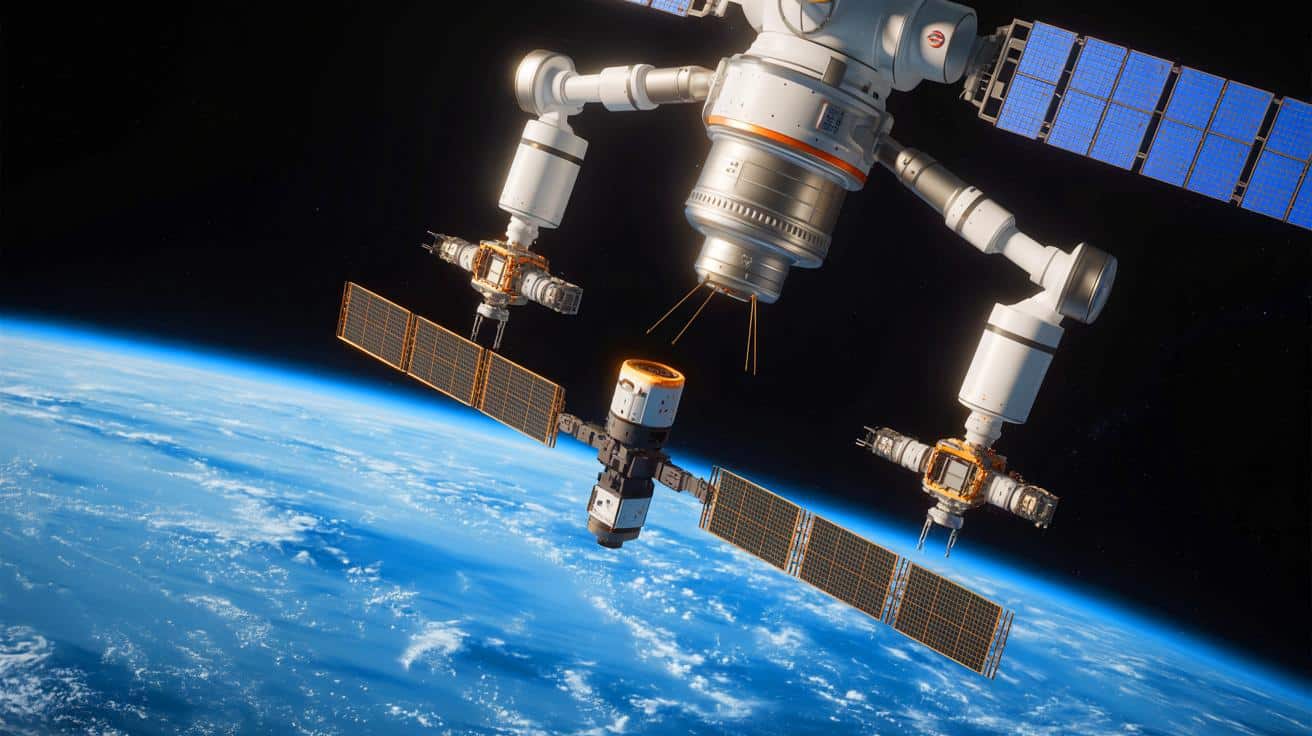IN A NUTSHELL
🛰️ The U.S. Naval Research Laboratory has achieved a milestone in space technology with a robotic servicing system.
🔧 The system can perform in-orbit repairs, inspections, and upgrades on geosynchronous satellites.
🤝 Collaboration with Northrop Grumman and DARPA has been crucial for the project’s success.
🚀 The upcoming launch will mark the start of a new era in satellite servicing and space operations.
The U.S. Naval Research Laboratory (NRL) has achieved a significant milestone in space technology, marking the culmination of more than two decades of research and development. The milestone involves the successful completion of space-readiness testing for a robotic system designed to service satellites in geosynchronous orbit. This groundbreaking development promises to revolutionize the satellite industry by enabling routine in-orbit inspections, repairs, and upgrades. The Robotic Servicing of Geosynchronous Satellites (RSGS) system, integrated with Northrop Grumman’s Mission Robotic Vehicle (MRV), has undergone rigorous testing in a cryogenic thermal vacuum chamber, simulating the harsh conditions of space.
Geosynchronous Orbit Servicing
Geosynchronous orbit, located approximately 22,000 miles above Earth, hosts hundreds of satellites that serve both military and commercial purposes. Due to their remote location, these satellites are challenging to inspect, diagnose, or repair. As a result, operators often build satellites with costly, heavy backup systems and additional fuel to compensate for the lack of in-orbit assistance. This approach, however, is neither cost-effective nor sustainable.
The NRL-developed robotic servicing technology aims to change this paradigm by allowing for close inspections, orbital adjustments, hardware upgrades, and in-orbit repairs. The system is equipped with two robotic arms, advanced avionics, and a suite of tools designed for Rendezvous and Proximity Operations. Cameras, sensors, and infrared imaging facilitate safe approaches to client satellites. The robotic arms are capable of performing tasks such as capture, inspection, and upgrades, with the flexibility to incorporate new tools as needed.
This technological advancement promises to extend the operational lifespans of satellites, reduce costs, and open new avenues for innovation. As Dr. Bruce Danly, NRL director of research, stated,
“The completion of spacecraft thermal vacuum testing marks the most critical milestone of recognizing that the NRL-developed payload and MRV are capable of working together as a system.”
https://www.rudebaguette.com/en/2025/09/physical-bodies-required-for-true-intelligence-ai-researchers-explore-whether-soft-robotics-and-embodied-cognition-unlock-artificial-general-intelligence/
Launch Expected Next Year
The cryogenic thermal vacuum chamber testing was completed at the NRL’s Naval Center for Space Technology (NCST) in Washington, D.C. Following this milestone, the RSGS-MRV system will proceed to Northrop Grumman’s facility in Virginia for final integrated systems testing. Once these tests are completed, the system will be prepared for launch, expected in 2026.
Upon reaching orbit, the MRV and its payload will undergo a series of demonstrations to validate their capabilities. These demonstrations will include proximity operations, rendezvous maneuvers, and client servicing tasks such as resolving satellite anomalies and performing hardware upgrades. The purpose of these trials is to confirm the system’s ability to extend and enhance the service life of satellites.
The upcoming launch marks the beginning of a new era in resilient space operations, as highlighted in the NRL’s press release:
“With launch preparations starting soon, RSGS is poised to demonstrate its robotic capabilities in orbit for the first time, marking the beginning of a new era in resilient space operations.”
https://www.rudebaguette.com/en/2025/09/we-built-a-walking-robot-from-just-18-metal-parts-tokyo-engineers-create-open-source-bipedal-robot-that-anyone-can-assemble-at-home/
Partnerships and Funding
This ambitious project is the result of a collaborative effort between the NRL and several key partners. Northrop Grumman’s SpaceLogistics division has played a crucial role in the development and integration of the MRV spacecraft bus, which hosts the RSGS payload. The Defense Advanced Research Projects Agency (DARPA) has also provided substantial funding to support the initiative.
Bernard Kelm, acting director of the Naval Center for Space Technology, emphasized the importance of this collaboration, stating,
“This is more than a successful test, we are nearing the culmination of decades of work and partnership that began as a vision for on-orbit servicing.”
Such partnerships are vital for advancing space technology and ensuring the successful implementation of innovative solutions that can address current and future challenges in satellite operations. The combined expertise and resources of these organizations are paving the way for a new standard in satellite servicing.
Implications for the Satellite Industry
The successful development and deployment of the RSGS system could have profound implications for the satellite industry. Currently, the economic model for satellite operations involves significant upfront costs and long-term investments in technology that may become obsolete before the satellite’s operational life ends. The ability to perform in-orbit servicing can drastically reduce these costs and extend the functionality of existing satellites.
This advancement also opens the door to new business models and opportunities for companies involved in satellite manufacturing and operations. The potential for routine maintenance and upgrades means that satellites can be designed with greater flexibility and adaptability, reducing the need for costly replacements.
Moreover, the environmental benefits of such a system cannot be overlooked. By extending the life of satellites and reducing the need for new launches, the RSGS system can contribute to reducing the space debris problem and promote more sustainable space operations.
As the space industry continues to evolve, the successful implementation of the RSGS system could serve as a catalyst for further technological advancements and innovations. What other breakthroughs might this technology inspire, and how will they shape the future of space exploration and satellite servicing?
This article is based on verified sources and supported by editorial technologies.
Did you like it? 4.3/5 (22)

